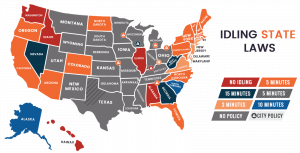Do you know enough about truck engine idling? In the trucking industry, there are many stops to be made. On average, a truck driver may spend up to 11 hours a day on the road (Flock Freight). That makes for very long days without much time for anything else. So when they are able to take a break, you better believe that truckers will take that opportunity.
If you are a truck driver, you know that, while rewarding, the job is demanding, the hours long, and there is not much time spent at home. That being said, how do you take your breaks? Do you schedule them out? Perhaps you stop whenever necessary and take the time to stay out of your truck for a while and stretch your legs, get something to eat, and use the restroom.
Read Also: Why is Truck Driving Such a Popular Career?
One thing that nearly all truck drivers have experienced is truck idling. This is a normal part of every truck driver’s average day, but there are certain things that you may not know about it. Continue reading for some information on what truck idling is, why it may be needed, why it isn’t recommended, and ways to avoid idling when possible.
What is Truck Engine Idling?
Truck idling is when a driver leaves the engine of the truck running, but the truck is not going anywhere. It may be parked or stuck in traffic. Sometimes it is unavoidable, but other times, truckers will leave the truck idling when they are at a rest stop, in non- or slow-moving traffic, while they sleep, or before the truck takes off to warm up the engine.
Why might truck engine idling be necessary?
Many truck drivers use idling for different reasons. While overall it can be avoided, there are some situations in which truck idling is necessary. Sometimes idling cannot be avoided, such as in cases like these:
- When a driver is stopped in traffic and cannot move anywhere at the time.
- When a driver is allowing the truck to build up air pressure for the release of its brakes.
- To keep items from freezing in non-temperature-controlled trucks during the winter.
- To run appliances from the truck’s electrical inverter without draining the battery.
In these circumstances, idling a truck may be unavoidable. It could be necessary to leave the truck idling, even when the driver is not behind the wheel.
Why idling a truck is not recommended?
There are several reasons why truck idling is not recommended and can even be harmful rather than helpful. While it may not be the intention of the driver to do any harm, it is possible that truck idling may do more harm than good. Below are some reasons why truck idling is not recommended and could potentially be harmful.
- Trucks waste thousands of gallons of diesel per year by idling. When a truck sits idling, it is still using gasoline, yet not going anywhere. Therefore, it is wasting gasoline and money.
- Idling a truck can shave quite a bit of time off of a truck’s engine. A truck’s engine can only do so much, and they have a certain span of time before they begin to break down. Idling a truck can lead to a much faster breaking down of the engine.
- Idling a truck emits hazardous pollution into the air. That’s right, when you are idling your truck, you are undoubtedly polluting the air and environment around you. According to the Environmental Defense Fund, for every 10 minutes that your engine is off, you prevent one pound of carbon dioxide (the leading cause of global warming) from being released.
As you can see, truck idling can be the cause of some serious problems and a waste of quite a bit of money. While sometimes it may be necessary, there may be other solutions that you can try instead of idling your truck.
What are some ways to be idle-free?
There are some alternatives to truck idling in certain situations. While it can’t be avoided in all situations, here are some alternatives and ways to be idle-free in those that it can:
- Turn off your engine if you are waiting for more than 10-20 seconds. Though many people believe that it wastes more fuel to reignite your engine, it actually wastes more fuel to sit there idling.
- Drive to warm up the engine, rather than idling. For truck drivers, you may have to idle for a while to warm up the engine. However, it shouldn’t take too long to get it ready to go. So rather than sitting there waiting for a long time, get driving. Make sure you are ready to go when you turn on your engine so that as soon as it is ready, you can head out.
- Begin driving in order to heat up the interior of the truck. While idling may do the trick, driving will actually heat things up faster and you won’t be wasting diesel and time.
- Use a portable A/C or heating unit rather than idling while you sleep. There are many options available, including ones that run on diesel and others that are battery-operated. These are excellent options if you use idling specifically for climate control in the truck and are readily available for purchase.
Truck idling is a very common occurrence with trucking, but it can come at a very high cost. Keeping idling down to a minimum is a great way to save money, time, and the environment. While you may not be able to 100% stop idling altogether, you may be able to cut down quite a bit with some of the tips listed above.
Read Also: Is It Boring to be a Truck Driver?
If you are a trucker and you use idling as a method for anything, then consider switching methods. It is easy and affordable to do so, and the environment will thank you. Keep these things in mind the next time you leave your truck idling. Switch off the engine when possible. It is such an easy fix to some rather big issues.

